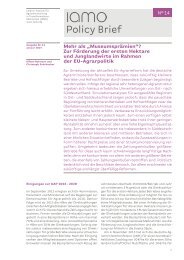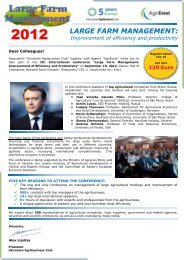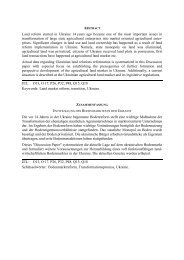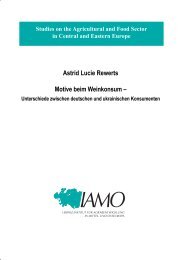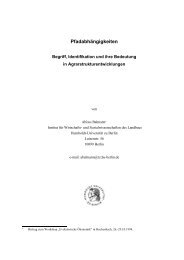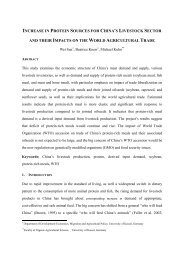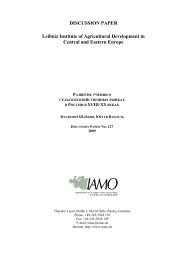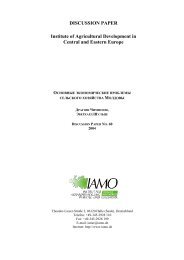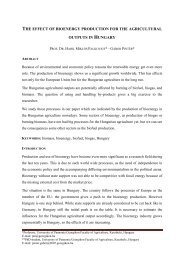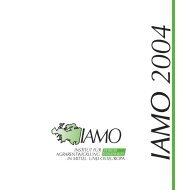Abstract - IAMO
Abstract - IAMO
Abstract - IAMO
You also want an ePaper? Increase the reach of your titles
YUMPU automatically turns print PDFs into web optimized ePapers that Google loves.
20 ANDREAS WILDERMUTH<br />
• overhead cost of organising crop insurance (accounting, personnel department etc.).<br />
• cost of acquiring information on the probabilities of the loss event and the loss distribution<br />
contingent on the occurrence of the loss event. The information thus acquired is necessary<br />
in order to reduce adverse selection problems.<br />
• cost of monitoring farms’ risk-reduction measures to combat moral hazard.<br />
• expected cost of loss adjustment.<br />
In the absence of subsidisation these costs would have to be charged to insured farmers in the<br />
form of an administrative cost loading. This loading would be added to the net risk premium,<br />
i.e. the expected value of the indemnity. Each insured farm would have to pay a share of the<br />
fixed cost of organising crop insurance.<br />
Now let us turn to the agency cost. In the case of remaining moral hazard and adverse<br />
selection problems the insurer has to write incentive-compatible contracts that involve secondbest<br />
risk-sharing arrangements for all or some insured farms, and thus involuntary riskbearing.<br />
This involuntary risk-bearing causes a welfare loss that is called agency cost. This<br />
cost can be measured by the increase in risk premiums that has been caused by the involuntary<br />
risk-bearing.<br />
Last but not least, let us take a look at the risk-loading cost. If risk markets are imperfect, the<br />
insurer or its equity-holders may be unable to completely diversify their risk. In this case the<br />
insurer has to be paid a risk loading to accept the risk. But note that in economies with welldeveloped<br />
risk markets the risk loading is likely to be relatively low.<br />
The second risk-management strategy is the self-insurance technology, which has the<br />
following costs:<br />
• Reduction in expected income.<br />
• If the self-insurance technology reduces only part of the income risk, the remaining income<br />
risk causes an additional welfare loss, which can again be measured by the agricultural<br />
enterprises’ risk premiums.<br />
If the farm seeks to minimise the cost of risk-management, it will choose crop insurance if the<br />
sum of its agency cost and its share in the cost of organising crop insurance is smaller than the<br />
cost of the self-insurance. Otherwise it will choose self-insurance.<br />
Step 2: Derivation of a condition for the insurability of a particular natural hazard<br />
Having obtained this result, the derivation of a necessary and sufficient condition for the<br />
insurability of a natural hazard is straightforward.<br />
The peril under consideration is insurable, if and only if it is possible to find a collective<br />
of farms for which the cost of crop insurance is lower than the cost of the self-insurance<br />
technology.<br />
The rationale of this condition is straightforward. We only want to mention that the condition<br />
has to be stated for collectives, because the existence of fixed costs of crop insurance creates<br />
economies of scale.<br />
Step 3: Discussion of welfare implications<br />
If a risk is insurable in the sense of our condition for insurability, does this mean that the<br />
introduction of insurance invariably increases social welfare? The answer to this question is



